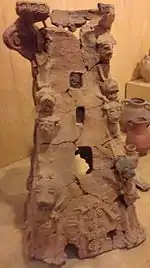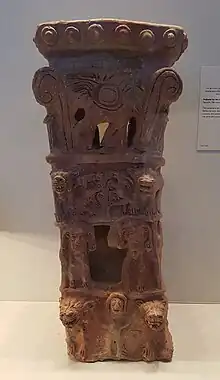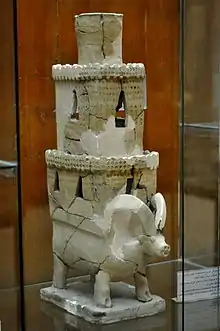Not to be confused with Cultic stand A from Ta'anakh.




The Ta'anakh cult stand was found in the ancient city of Ta'anakh, near Megiddo, in Israel. It dates back to the 10th century BCE and has various images that are related to the religious practices of the Israelites. Some think that the "elaborate" 53cm[2] stand was used for offering incense[1] to the gods, while others suggest that it was a miniature representation of a temple or a shrine. The stand has four tiers.
The fenestrated (window-bearing[3]) stand is one of the most important archaeological discoveries for the study of ancient Near Eastern religions, especially the cults of Yahweh and his consort[4] Asherah. Many publications have referred to this connection, especially before the 2010s publications of the more blatantly Asheratic Kuntillet Ajrud inscriptions. In fact, the stand and the inscriptions are called "as notable" as the Lachish ewer.[5]
A few such cult stands were found in Pella and Lachish though "most were unfortunately purchased from grave robbers". They are clearly connected with Late Bronze and Early Iron Age traditions, showing continuity of worship of the goddess Asherah ("known all over the Levant as the Lion Lady") in Israel during the 10th century. The Lachish cult stand was found with a limestone altar and massebot in a small cultic room associated with a public shrine. They could have held gifts, bowls, libations.[6]
Depiction
Not depicted
It's not immediately clear if any of the creatures are meant to depict Yahweh, who's typically shown as anthropomorphic, bovine, or between. Some suggest the windows (this is a fenestrated cult stand, in antiquarian jargon) are in fact voids, i.e.: where God is not shown, as aniconism would rise later from the Babylonian captivity to the Maccabean period, but "[a]n early aniconism... is purely a projection of the post-exilic imagination".[7]
Depicted
Asherah in embodied form with her typical symbols, and in her[8] form of a small sacred tree. There's also a larger tree without the personal equivalence: "In the Ta'anach stands, the tree is an upright trunk with several furled fronds coming out from the two sides; in one case six and in the other eight." On the upper (IV) storey is the divine sun with a horse, showing[4] a solar-equine motif as central that would persist in Hebrew Zodiac art into the common era.
See also
External
- Goats and animal visages show greater comprehensibility in this photo https://www.megalithic.co.uk/modules.php?op=modload&name=a312&file=index&do=showpic&pid=81831
Bibliography
- Taylor, Joan E. (1995). "The Asherah, the Menorah and the Sacred Tree". Journal for the Study of the Old Testament. SAGE Publications. 20 (66): 29–54. doi:10.1177/030908929502006602. ISSN 0309-0892.
- MacDonald, Nathan (2007). "Aniconism in the Old Testament". In Gordon, R.P. (ed.). The God of Israel. Cambridge University Press. ISBN 978-0-521-87365-9.
References
- 1 2 Taylor 1995, pp. 29–54.
- 1 2 Stuckey, Johanna H. (2002-01-01). "The Great Goddesses of the Levant". Journal for the Study of Egyptian Antiquities. Retrieved 2023-12-09.
- ↑ "finding detail". antiquities.org.il. Retrieved 2024-01-07.
- 1 2 Doak, Brian R. (2007-11-18). "A Reevaluation of Some Iconographic Motifs on the Taanach Cult Stand". Digital Commons @ George Fox University. Retrieved 2023-11-04.
- ↑ Hestrin, Ruth (1987). "The Lachish Ewer and the 'Asherah". Israel Exploration Journal. Israel Exploration Society. 37 (4): 212–223. ISSN 0021-2059. JSTOR 27926074. Retrieved 2023-12-28.
- ↑ Beaulieu, Stéphane (2007-01-01). "Eve's Ritual: the Judahite Sacred Marriage Rite". Concordia University. Retrieved 2023-12-09.
- ↑ MacDonald 2007, pp. 21, 26–27.
- ↑ Taylor 1995, pp. 32.